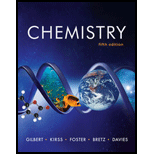
Concept explainers
Interpretation: The given two alloys
Concept introduction: An alloy is a solution that is made up of mixing of atoms of an element with other element which results in change in properties of the host element. Gold and silver both crystallize in a face centered cubic unit cell.
The density of the unit cell is calculated by the formula,
To determine: The alloy that is denser.
Answer to Problem 12.97AP
Solution
The alloy
Explanation of Solution
Explanation
Gold and silver both crystallize in a face centered cubic unit cell.
There are 4 atoms in an fcc unit cell.
The molar mass of
The mass of a unit cell is calculated by the formula,
Substitute the value of the molar mass of
The given edge length is
The volume of an
Substitute the value of the edge length in the above formula.
Density is calculated by the formula,
Substitute the value of the mass and volume of the unit cell in the above expression.
Therefore, the density of
The mass of a unit cell is calculated by the formula,
The mass of
The given edge length is
The volume of an
Substitute the value of the edge length in the above formula.
Density is calculated by the formula,
Substitute the value of the mass and volume of the unit cell in the above expression.
Thus, the density of
Therefore, the alloy
Conclusion
The alloy
Want to see more full solutions like this?
Chapter 12 Solutions
Smartwork5 Printed Access Card for Use with Chemistry: The Science in Context 5th Edition (SmartWork Access Printed Access Card)
 ChemistryChemistryISBN:9781305957404Author:Steven S. Zumdahl, Susan A. Zumdahl, Donald J. DeCostePublisher:Cengage Learning
ChemistryChemistryISBN:9781305957404Author:Steven S. Zumdahl, Susan A. Zumdahl, Donald J. DeCostePublisher:Cengage Learning ChemistryChemistryISBN:9781259911156Author:Raymond Chang Dr., Jason Overby ProfessorPublisher:McGraw-Hill Education
ChemistryChemistryISBN:9781259911156Author:Raymond Chang Dr., Jason Overby ProfessorPublisher:McGraw-Hill Education Principles of Instrumental AnalysisChemistryISBN:9781305577213Author:Douglas A. Skoog, F. James Holler, Stanley R. CrouchPublisher:Cengage Learning
Principles of Instrumental AnalysisChemistryISBN:9781305577213Author:Douglas A. Skoog, F. James Holler, Stanley R. CrouchPublisher:Cengage Learning Organic ChemistryChemistryISBN:9780078021558Author:Janice Gorzynski Smith Dr.Publisher:McGraw-Hill Education
Organic ChemistryChemistryISBN:9780078021558Author:Janice Gorzynski Smith Dr.Publisher:McGraw-Hill Education Chemistry: Principles and ReactionsChemistryISBN:9781305079373Author:William L. Masterton, Cecile N. HurleyPublisher:Cengage Learning
Chemistry: Principles and ReactionsChemistryISBN:9781305079373Author:William L. Masterton, Cecile N. HurleyPublisher:Cengage Learning Elementary Principles of Chemical Processes, Bind...ChemistryISBN:9781118431221Author:Richard M. Felder, Ronald W. Rousseau, Lisa G. BullardPublisher:WILEY
Elementary Principles of Chemical Processes, Bind...ChemistryISBN:9781118431221Author:Richard M. Felder, Ronald W. Rousseau, Lisa G. BullardPublisher:WILEY





